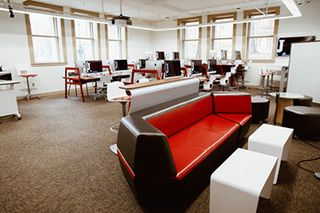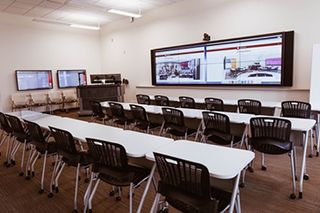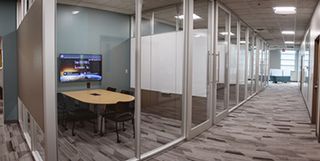
Julie Johnston, Director of Learning Spaces, University Information Technology Services, Indiana University. Portrait by Madeleine Decker, Bloom Photography.
Julie Johnston knows the power and promise of an intuitive user experience. Johnston leads the Learning Space team at Indiana University, Bloomington, consisting of Student Technology Center, Technology Center Consulting, Learning Space Design, Collaboration Technologies, and Classroom Technology Services and Support. Julie has become a formidable force in the edtech world, and her Mosaic Initiative is now synonymous with exemplary active learning. Julie is helping us think differently about interactivity, and she encourages education and tech stakeholders to reimagine learning space design. We were fortunate to ask Julie to share her candid insights about emerging technologies, pegdagogy, and UX.
What is your active learning philosophy (Mosaic)?
We continuously seek innovative technology solutions for our spaces that encourage and foster the creative learning experience for our students. We believe space design incorporates a symbiotic ecosystem of space, technology, and pedagogy.
Space design should begin with a question: “What does the experience for the student, instructor, or other user of the space look like?” We named our active learning initiative Mosaic because we believe spaces should be created with purposeful intention and we have created a “mosaic” of spaces based on the need of the faculty and students in the space. Our goal is to create a mosaic of active learning spaces to support a variety of pedagogical strategies.
How is AV/IT convergence playing out in your facility?

Collaborative Computer Lab in the School of Art and Design IU Bloomington.
Photo by Madeleine Decker, Bloom Photography.
My portfolio is responsible for both AV/IT services. Because of the structure of my team, AV/IT has naturally converged into a dynamic and collaborative design and support model. In today’s technology world, this structure is imperative in order to provide a streamlined set of tools and services to the end user and avoid issues related to vision/end user operability, etc.
What AV/IT problems have you solved recently?
The introduction of wireless collaboration for all users in the majority of presets, automated content, “just-in-time” information on mobile devices, and auto login based on user, to name a few. In addition, we are opening up the Idea Garden, a creative brainstorming space for students to explore and experiment with a variety of technologies including IoT as well as virtual reality to solve real-world problems. Our team is proactively exploring how to use beacons to enhance the student experience on campus.
What AV/IT do you hope to buy in the near future? Why?

Media School Interactive Newsroom Classroom – Touch Planar Video Wall with Mersive Solstice.
In our new Idea Garden opening this spring we will be providing a new virtual reality experience with Liquid VR Ready CPUs connected to a video wall. This technology is designed to reduce unwanted processing latency to deliver a consistent frame rate. The consistency of the experience is noted to be the game changer in providing an experience to alleviate the nausea some users experience with Virtual Reality. An added benefit is the aesthetically pleasing systems that will provide a highly innovative design element to our space.
We are currently providing VR-ready machines and the Vive headsets for many of our Reality Labs on campus. Many of the students at Indiana University have moved beyond the basics and are seeking tools that can advance their skillsets, creatively and scientifically, to be more competitive in the workplace.
We hope to provide students with more advanced learning technology tools such as the Microsoft Hololens, and the Microsoft Surface Studio for creative high-end development.
The computing environments for instructional settings with our new designs are more collaborative and engaging. We are currently working on designing an immersive technology instructional computing lab where we will incorporate R1800 curvature monitors designed to immerse the user into the experience.
Where are technology manufacturers getting it wrong or missing opportunities?
Some of the emerging technologies I have encountered recently are simply not designed for an educational environment. Many features that work well in the commercial market cannot be fully implemented in higher education. Our environment requires us to select technologies that are able to scale to the enterprise level securely for a reasonable cost. Ongoing usage-based licensing terms and high yearly maintenance fees hinder higher education from adoption. In addition, technology designed for a single user for a more personalized environment does not scale well to the enterprise for a multi-user setting. As we implement new innovations, we have to overcome many roadblocks in order to scale in our environment.
What is the biggest obstacle to collaboration? What are your collaboration strategies?

Informal Learning Space - Student Technology Center in Teter Residence Hall.
Image by IU’s photography team.
The biggest obstacle to collaboration is when individuals or groups work in a vacuum and don’t build a team based on strengths to complement each other and work together on a shared vision.
At the onset of any project, I gather a team of individuals who represent the many skill sets necessary to successfully implement the initiative. We identify the missing links and seek to find representatives needed in those areas. My best example of a recent successful collaboration is when we initiated our Reality Lab classrooms. This project implemented virtual reality in a more general classroom environment. We planned the project by convening teams from the Advanced Visualization Lab, faculty who were leading VR implementations, the Student Technology Center team, and the Learning Space Design team. By convening a talented and diverse group, this project has flourished and continues to grow. Without combining forces from a variety of stakeholders with varying strengths, these spaces would not exist.
The wide variety of software tools available to the end user in an organization can actually be an obstacle to enhance the collaboration process. Indiana University has a wide variety of avenues in which to foster the collaborative process. I personally have not identified one particular strategy for electronic collaboration. For example, I sometimes work within our Box enterprise to create a real-time box note simultaneously with my team, brainstorm on a white board, and use the Capture app to automatically upload that image to a selected Box folder. On other occasions, I work within our Google enterprise to create a variety of Google docs, spreadsheets, etc. We are piloting cloud collaboration strategies that provide you with ongoing access to your vision and brainstorming content using the Google Jamboard with a Jamboard session. The future of collaboration tools in the cloud is continuous access of all brainstorming and project planning content for all users on collaborative team on a project.
What do you see as the next-gen challenges of ed tech in an ever-connected world?

Collaborative Computer Lab in the School of Education – pre-service teachers in action – exploring robotics. Image by IU’s photography team.
One big challenge: With so many new tech options to choose from, you really have to be careful not to create a disjointed technology experience for your end user. Users rely on a variety of tools and features of specific technology and software solutions, which can result in a complex end user environment.
In addition, new technologies are introduced into an already expansive list of tools, confusing the intent and experience. A wide variety of companies are experimenting with emerging technologies, but there may be a disconnect between the hype and the reality of the impact. Another challenge is the introduction of a wide variety of mobile recording apps and lecture capture recording devices, which introduce privacy concerns for students and faculty.

